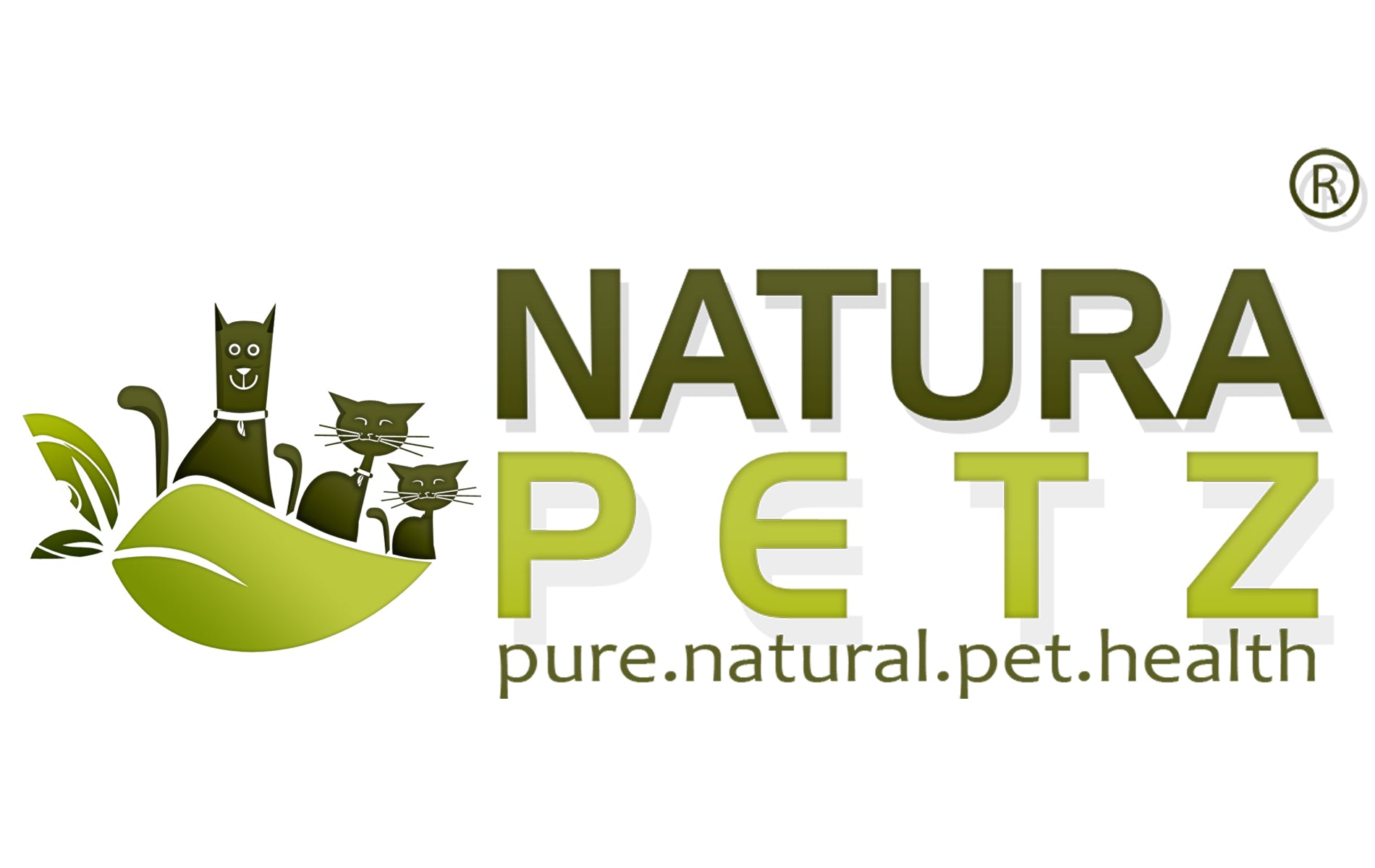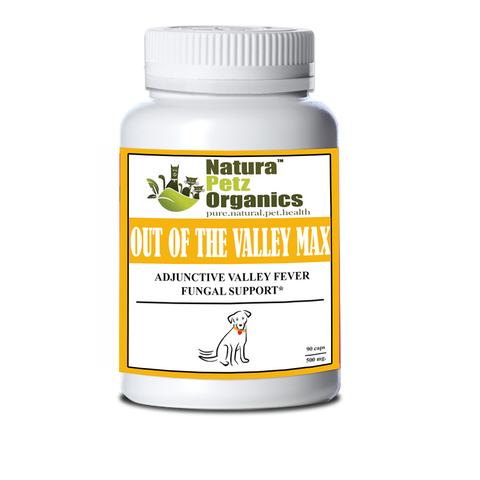OUT OF THE VALLEY MAX* ADJUNCTIVE VALLEY FEVER FUNGAL SUPPORT* for Dogs and Cats
SKU: OUTOFVALLEYDOG90OUT OF THE VALLEY MAX* ADJUNCTIVE VALLEY FEVER FUNGAL SUPPORT* for Dogs and Cats
Valley Fever, also known as Coccidioidomycosis, is an infection caused by the fungus Coccidiodes immites or Coccidioides posadasii organisms, which infects a mammal when it breathes in microscopic fungal spores found in affected dust and soils. While it primarily affects the lungs and respiratory organs, it can spread to other parts of the body, and in some cases if not treated, can be deadly related to Valley Fever pneumonia.
OUT OF THE VALLEY MAX* is used in traditional, medical systems as an adjunctive to help limit yeast and fungal infections and systemic Candida in the stomach and intestines, for its natural phytochemical support which may help inhibit infection, may help limit cough and lung inflammation, may help support proper smooth muscle function in the respiratory and digestive tract, may help cool excess inflammation, may help moderate fever and appetite loss, may help restrict vomiting and diarrhea, may help moderate excess mucous production, may help heal wounds and may help reduce scarring in the lungs and respiratory tracts.
Additionally, OUT OF THE VALLEY MAX* may help counteract bloody diarrhea and may inhibit bowel contractions related to acute diarrhea and enteritis, which can occur with Valley Fever infection, by helping inhibit the chemical processes found in diarrhea and may help aid in the re-absorption of water in the intestines.
OUT OF THE VALLEY MAX* contains a diverse array of herbal adaptogens, including lapachol, which may help disrupt the necessary energy and ATP electron transport system that fungi require to survive and spread. It may also restrict the ability of fungi to "breathe," leading to fungal cell death. In South American traditional, herbal medical systems, the anti-fungal actions of its herbal formulation are considered as effective as the synthetic drugs ketoconazole and Multifungin®.
OUT OF THE VALLEY MAX* has other important plant actions against Valley Fever, including its function as a protease inhibitor. Proteases are enzymes that digest protein and are present in every living cell, of every living thing. Protease inhibitors disable enzymes from making viral copies that allow Valley Fever to proliferate. With the protease enzyme blocked, Valley Fever is unable to make copies of the virus to infect other cells.
OUT OF THE VALLEY MAX* also contains plants that have mirabilis antiviral and anti-fungal proteins (MAPs), plant actions that protect against viruses and soil-borne fungi infection like Valley Fever and inhibit cellular processes in viral cells required to spread., possibly limiting infection rates with use.
OUT OF THE VALLEY MAX* may act as a broad-spectrum antimicrobial for various internal and external infections, and its phenylheptatriyne content is particularly virulent against fungal pathogens, especially for its potential actions to help dissolve biofilm that fungal Candida creates and relies on to proliferate. OUT OF THE VALLEY MAX* plants may work to help interrupt biofilm creation, including Gram-positive and Gram-negative fungi and bacteria, as well as may help kill the underlying bacteria, that enables Valley Fever to spread.
OUT OF THE VALLEY MAX* may also help with a dry, hacking cough, hemoptysis (coughing blood up from the lungs), upper respiratory and cardiopulmonary breathing problems, lung weakness, hemorrhages, and other idiopathic respiratory disorders and distresses, may help expel intestinal worms and parasitic infestations and may help address conditional needs related to difficult to treat foot and nail fungus.
OUT OF THE VALLEY MAX* contains plant compounds that have unique features in regard to immune modulation, in which it increases the actions of specific immune cells tasked with identifying and removing foreign cells like fungus and bacteria. It also contains a novel cytokine switching mechanism which down regulates cytokines from the Type I helper cells (Th -1 cell) pathway that contain many pro-inflammatory cytokines, and instead up-regulates Type 2 helper cells (Th-2) pathway, to help nudge the body toward homeostasis, or body balance, when it has been disrupted.
Natural, plant actions of OUT OF THE VALLEY MAX* include primary anti-fungal, anti-yeast, anti-Candidal, anti-diarrheal, anti-dysenteric, insecticide (safe for pets, lethal to opportunistic parasites), anti-amebic, antiprotozoal, anti-bacterial, anti-inflammatory, anti-spasmodic, expectorant, plant based antibiotic and steroid, anti-septic, vulnerary (wound healer), anti-microbial, gastro-protective, smooth muscle promoter, analgesic, digestive, strongly antioxidant, stimulant, tonic (body systems energizer and fortifier that tones, balances and strengthens body systems), decongestant, expectorant, anti-tussive, purgative, molluscicidal, anti-spasmodic, astringent, carminative (expels gas), cough suppressant, anti-histamine, anti-allergenic, antitumor, diabetic, hepatoprotective, hypoglycemic (due to significant reduction in blood sugar levels), anti-plasmodium, diuretic,), vermifuge (expels worms), and febrifuge (reduces fever.)
Valley Fever exists in two forms (environmental and host), and it can be both acute and chronic symptomatically, meaning symptoms can present after 3 weeks of exposure in a sudden, acute, manner, but if the initial exposure is not resolved, it may progress to a chronic form of pneumonia, which is common in pets with weakened immune systems. Valley Fever can also go into self-remission, or dormancy, once treated, and can linger for months in the body, to be reactivated at a future date.
Natural plant chemicals include glycosides, lipids, alkaloids, flavonoids, tannins, cardenolids, triterpenes, diterpenes, terpenes, polyphenols, steroids, resins, steroidal saponins, phenylpropanoids, lipids, proanthocyanidins, sesquiterpenes, phenols, phytosterols, lignans, flavones, benzenoids, dibenzyl trisulfide, novel cayophyllene and caryophyllene acids, oxindole alkaloids, oligosaccharides. phenolic and phytic acids, novel astilbin and copalic, kaurenic and keurenoic acids, benzenoids, carotenoids, lectins, vitamins, fiber. quercetin, fatty acids and more.
While Valley Fever affects both dogs and cats, it tends to be more common in puppies, kittens, and senior, immuno-compromised and large-breed, male dogs. Valley Fever symptoms are also variable from one mammal to the next, and in some cases, an animal can take months to recover. If exposure is not managed early, it commonly leads to Valley Fever pneumonia, which can be deadly.
The environmental form of Valley Fever is a mold, found largely in soil, which can go dormant for long periods of time and later can be reactivated by rain, or an auto-immune failure experienced by an animal host. When Valley Fever is activated, it produces fungi, accompanied by infectious spores that can be carried by the wind. Once inhaled, it morphs into a yeast-like organism that infects the lungs. The fungus then forms spherules, which replicate continually, moving to other organs to continue its attack.
There are 2 stages of severity associated with Valley Fever: Primary Disease and Dissemated Disease.
Primary Disease is generally limited to the lungs, and symptoms include fever, a dry, harsh cough, lack of appetite, fatigue, lethargy, withdrawal from activities and depression.
Dissemated Disease occurs when the fungus spreads to other parts of the body, and primarily impacts the bones and joints, accompanied by lameness and pain. It can also include the symptoms of Primary Disease. Your dog may then experience severe joint pain, lameness, and potential neurological symptoms such as seizures. This form of Valley Fever may require a different formulation to fully address joint mediated pain and lameness.
Valley Fever Pneumonia symptomatically can include fever, weight loss, a consistent, dry, and sometimes hacking cough, chest pain, blood-tinged sputum discharged when coughing and nodules in the lungs. Canine and feline fungal pneumonia can be life-threatening and usually affects young puppies, kittens, senior pets, and pets with compromised immunity. Pneumonia can be brought on by a weakened immune system that has been overwhelmed by bacteria, virus, fungus, toxins, and other parasites.
INGREDIENTS: Proprietary adaptogen blend that includes herbs such as Jatoba and Pau d Arco.
CONTRAINDICATIONS: Do not use with pregnant or nursing animals, 2 weeks prior to surgery, for pets with hypoglycemia or bleeding or cardiac disorders. May be contraindicated for pets with low blood pressure.
DRUG INTERACTIONS: Interacts with digitalis, anti-diabetic, anti-coagulant, anti-hypertensive, and ACE-inhibitor drugs and vitamin K. May potentiate heart, anti-diabetic, insulin, low and high blood pressure, anticoagulant, and hypoglycemic drugs.
CAUTIONS: Cautioned for use with diabetic, Coumadin, Warfarin®, heart, high blood pressure and low blood pressure meds.
DOSAGE:
 Menu
Menu














